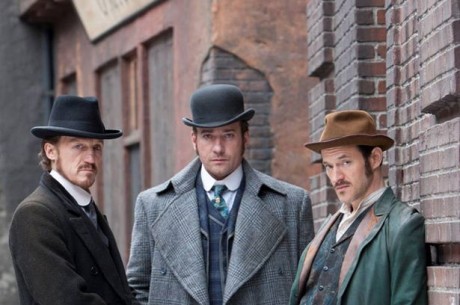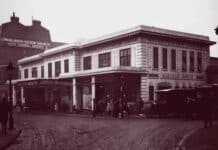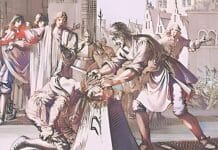Ripperologist MIKE COVELL runs his expert eye over the new BBC Victorian London crime series, Ripper Street
Last night, Sunday December 30th 2012, marked the showing of the first episode of BBC’s Ripper Street.
A long awaited show that was said to give an idea what the people in Whitechapel felt in 1889, the year after the notorious murders which were ascribed to an unknown assailant, known only as “Jack the Ripper”.
As a Ripperologist this got me very excited, and for months I would count down until showing, readying my Sky+ planner to record the series in HD, and hoping that a DVD release would soon follow.

1889 – A brief background
1889 was a fascinating year by anyone’s standards. Parts of a torso were washed up along the Thames between May and June 1889, leading to the discovery that the body was one Elizabeth Jackson. Furthermore Alice McKenzie had been found dead on July 17th 1889, and The Pinchin Street Torso was discovered on September 8th 1889.
The British press were still reporting on the events of the previous year, as well as the tragedies mentioned above, as well as several other Ripper Scares in Scotland, Bradford, and Walworth. There was also a reported Ripper Scare as far away as Madrid! With all this going on the police in Whitechapel were extra vigilant, and even they came in for a bashing, when, in September 1889, Sergeant William Thick of H Division was accused of being “Jack the Ripper.” The year was also the year that the Cleveland Street Scandal broke, when a high class brothel was raided and Inspector Abberline was involved on behalf of the police.
There was certainly plenty going on through the year to make the show exciting and base events around genuine events of the time.
Ripper Street – The Show
The show started at 21.00 on Sunday December 30th 2012 and got off to an alright start. The streets, buildings, and costumes looked amazing, and the overpopulated grime-ridden backstreets of Whitechapel were really well done. The transportation at the time was also fantastic, and nice to see onscreen. We are quickly introduced to the two main characters, the Detective Inspector Edmund Reid (played by Matthew Macfadyen) and Detective Sergeant Bennet Drake (played by Jerome Flynn).
We are then whisked back to Whitechapel for a Ripper tour, where the guide tells us that the Ripper crimes occurred the year before, and that we are now entering Miller’s Court. The problem here of course, is that it looked nothing like Miller’s Court and more like a series of nondescript alleys.
The guide then finds the body of a woman laid on the floor and apparently dead. I assumed at this point, as the show was based after the Ripper murders in 1889, that this was Alice McKenzie, but I would be proved wrong when the show revealed it was not named after any of the genuine victims but called Maude Thwaites.
By the time the police arrived a photographer is on scene, looking very shifty, and the body is laid out. On the wall is some graffiti, similar to that found at Goulston Street which was found by PC Long at 2.55am on the morning of September 30th 1888 after the murder of Catherine Eddowes who was discovered by Constable Edward Watkins at 1.30am that morning. At this point my wife, who is not a Ripperologist but puts up with my Ripperological lectures turned to me and whispered “Graffiti in 1889?”
The body was carried to a wagon and removed to Leman Street Police Station, where it was hidden in a cell and an American doctor is called. This American, played by Adam Rothernberg, is Captain Homer Jackson, a former member of Pinkerton’s Detective Agency, and not unlike Sherlock Holmes. At the time we meet him he is in a brothel indisposed. This sets the tone for the rest of the show.
Eventually we meet Abberline. The real Abberline enlisted with the Met police on January 5th 1863, initially working for N Division, but working his way up through the ranks. In 1888, at the time of the Ripper murders, he was working for Scotland Yard Central Office as an Inspector First Class, but after the murder of Mary Ann Nichols on August 31st 1888 he was seconded to Whitechapel’s H Division.
Abberline was played by Clive Russell, an English born, Scottish raised, actor who played the Dorset born police inspector, as a Cockney. It should also be noted that during this time Abberline was 46, being born in 1843, but Clive Russell is 67 years old, making Abberline some 21 years older than he actually is. That said, the actor did not play him as a drunk or drug addict as Michael Caine and Johnny Depp did respectively, and Abberline seemed to be as one would expect, upright, stern, and a man who is respected by his peers.
The murdered woman lead the team on a rollercoaster ride through the East End of London, to high class brothels, illegal bare knuckle fights, and through the shady world of Victorian pornography. As the plot developed, the pornography ring turned into a high class snuff movie ring, with prostitutes removed from the streets, only to be made to star in pornographic snuff movies, to be killed off, and dumped back on the streets to make it look like “Jack the Ripper” had returned.
The main nemesis in the story is Sir Arthur Donaldson, who is played with relish by Mark Dexter. Ripperologists will remember Mark Dexter in From Hell (2001) playing the dual role of Albert Sickert and Prince Edward Albert Victor.
Whilst there were a few references to the original Ripper murders, I found the links few and far between. The costumes and sets in Ripper Street were fantastic, the pace was slick, and the script had a few stand out moments, the fire in the photography dark room being one, but overall I felt let down.
Here is hoping that the second episode of Ripper Street makes up for the lack of Jack.
Discover how Spooky Isles help save Ripper Street!







